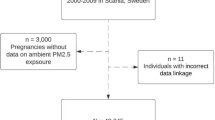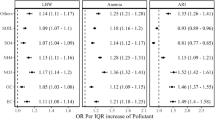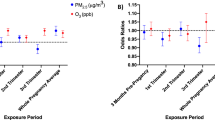Abstract
Background
Research demonstrates that chronic exposure to fine particulates (PM2.5) increases risks of neurodevelopmental conditions, such as intellectual disability (ID). Few studies have examined neurodevelopmental health impacts of pollution spikes exceeding 24-h (24-h) PM2.5 guidelines, despite relevance to the regulatory landscape. The current potential for regulatory changes to 24-h PM2.5 standards in the United States makes research on exceedances relevant.
Objective
To examine associations between 24-h PM2.5 exceedances and the risk of ID.
Methods
We conducted a retrospective case-control study of a sample of children in Utah, USA. We used generalized estimating equations to predict odds of ID based on the number of 24-h PM2.5 exceedance days during the preconception period and three trimesters of pregnancy. Exceedance days are defined as per current World Health Organization (WHO) [≥15 μg/m3] and current US Environmental Protection Agency (EPA) [≥35 μg/m3] 24-h guidelines.
Results
PM2.5 exceedances are associated with ID risk during the preconception and first trimester periods and not the second and third trimesters. During the preconception period, each day exceeding 15 μg/m3 or 35 μg/m3 was associated with a 1.023 (CI: 1.011–1.040) or 1.042 (CI: 1.026–1.059, p < 0.001) increase in odds of ID, respectively. During the first trimester, each day exceeding 15 μg/m3 or 35 μg/m3 was associated with a 1.032 (CI: 1.017–1.047) or 1.059 (CI: 1.030–1.088) increase in odds of ID, respectively.
Impact statement
-
Potential regulatory movement on the US 24-h PM2.5 standard makes research that explicitly studies exceedances highly relevant. Yet few studies examine health effects of exceeding 24-h guidelines for any air pollutants. This study fills important gaps in the literature by examining associations between odds of intellectual disability and the count of days exceeding current 24-h PM2.5 guidelines, as established by the World Health Organization and US Environmental Protection Agency, during the prenatal period. We find that exceedances of both sets of guidelines, during the preconception and first trimester periods, are associated with ID risk.
This is a preview of subscription content, access via your institution
Access options
Subscribe to this journal
Receive 6 print issues and online access
$259.00 per year
only $43.17 per issue
Buy this article
- Purchase on Springer Link
- Instant access to full article PDF
Prices may be subject to local taxes which are calculated during checkout
Similar content being viewed by others
Data availability
The authors cannot make the data publicly available nor are they permitted to share the data with other researchers, due to their sensitive nature. Researchers wishing to obtain the data can apply to access it directly via the Utah Resource for Genetic and Epidemiologic Research, the Utah Department of Health and Human Services, and the Utah Registry of Autism and Developmental Disabilities Oversight Committee.
References
Ballester F, Medina S, Boldo E, Goodman P, Neuberger M, Iñiguez C, et al. Reducing ambient levels of fine particulates could substantially improve health: a mortality impact assessment for 26 European cities. J Epidemiol Community Health. 2008;62:98–105.
Di Q, Dai L, Wang Y, Zanobetti A, Choirat C, Schwartz JD, et al. Association of short-term exposure to air pollution with mortality in older adults. J Am Med Assoc. 2017;318:2446–56.
World Health Organization. What are the WHO air quality guidelines? Geneva: World Health Organization; 2021 Available from: https://www.who.int/news-room/feature-stories/detail/what-are-the-who-air-quality-guidelines.
US Environmental Protection Agency. EPA Proposes to Strengthen Air Quality Standards to Protect the Public from Harmful Effects of Soot Research Triangle Park, NC2023 [Available from: https://www.epa.gov/newsreleases/epa-proposes-strengthen-air-quality-standards-protect-public-harmful-effects-soot.
US Environmental Protection Agency. NAAQS Implementation Process Research Triangle Park, NC2022 Available from: https://www.epa.gov/criteria-air-pollutants/naaqs-implementation-process#:~:text=EPA%20considers%20public%20input%20before,federal%20implementation%20plan%20(FIP).
Pope R, Stanley KM, Domsky I, Yip F, Nohre L, Mirabelli MC. The relationship of high PM2. 5 days and subsequent asthma-related hospital encounters during the fireplace season in Phoenix, AZ, 2008–2012. Air Qual Atmos Health. 2017;10:161–9.
Reid CE, Considine EM, Watson GL, Telesca D, Pfister GG, Jerret M. Associations between respiratory health and ozone and fine particulate matter during a wildfire event. Environ Int. 2019;129:291–8.
Volk HE, Perera F, Braun JM, Kingsley SL, Gray K, Buckley J, et al. Prenatal air pollution exposure and neurodevelopment: A review and blueprint for a harmonized approach within ECHO. Environ Res. 2021;196:110320.
Harris MH, Gold DR, Rifas-Shiman SL, Melly SJ, Zanobetti A, Coull BA, et al. Prenatal and childhood traffic-related air pollution exposure and childhood executive function and behavior. Neurotoxicol Teratol. 2016;57:60–70.
Harris MH, Gold DR, Rifas-Shiman SL, Melly SJ, Zanobetti A, Coull BA, et al. Prenatal and childhood traffic-related pollution exposure and childhood cognition in the project viva cohort (Massachusetts, USA). Environ Health Perspect. 2015;123:1072–8.
Fuertes E, Standl M, Forns J, Berdel D, Garcia-Aymerich J, Markevych I, et al. Traffic-related air pollution and hyperactivity/inattention, dyslexia and dyscalculia in adolescents of the German GINIplus and LISAplus birth cohorts. Environ Int. 2016;97:85–92.
Guxens M, Garcia-Esteban R, Giorgis-Allemand L, Forns J, Badaloni C, Ballester F, et al. Air pollution during pregnancy and childhood cognitive and psychomotor development: six European birth cohorts. Epidemiology. 2014;25:636–47.
Becerra T, Wilhelm M, Olsen J, Cockburn M, Ritz B. Ambient air pollution and autism in Los Angeles County, California. Environ Health Perspect. 2013;121:380–6.
Flanagan E, Malmqvist E, Rittner R, Gustafsson P, Källén K, Oudin A. Exposure to local, source-specific ambient air pollution during pregnancy and autism in children: a cohort study from southern Sweden. Sci Rep. 2023;13:3848.
Volk HE, Lurmann F, Penfold B, Hertz-Picciotto I, McConnell R. Traffic-related air pollution, particulate matter, and autism. JAMA Psychiatry. 2013;70:71–7.
Dutheil F, Comptour A, Morlon R, Mermillod M, Pereira B, Baker JS, et al. Autism spectrum disorder and air pollution: A systematic review and meta-analysis. Environ Pollut. 2021;278:116856.
Ke L, Feng G, Zhang Y, Ma X, Zhao B, Sun Y, et al. Causal effects of prenatal and chronic PM2. 5 exposures on cognitive function. Environ Res. 2023;219:115138.
Lei X, Zhang Y, Wang Z, Lu Z, Pan C, Zhang S, et al. Effects of prenatal exposure to PM2. 5 and its composition on cognitive and motor functions in children at 12 months of age: The Shanghai Birth Cohort Study. Environ Int. 2022;170:107597.
Wang H, Zhang H, Li J, Liao J, Liu J, Hu C, et al. Prenatal and early postnatal exposure to ambient particulate matter and early childhood neurodevelopment: A birth cohort study. Environ Res. 2022;210:112946.
Bansal E, Hsu H-H, Water ED, Martínez-Medina S, Schnaas L, Just AC, et al. Prenatal PM2. 5 exposure in the second and third trimesters predicts neurocognitive performance at age 9–10 years: A cohort study of Mexico City children. Environ Res. 2021;202:111651.
Patrick ME, Shaw KA, Dietz PM, Baio J, Yeargin-Allsopp M, Bilder DA, et al. Prevalence of intellectual disability among eight-year-old children from selected communities in the United States, 2014. Disabil Health J. 2021;14:101023.
Huang J, Zhu T, Qu Y, Mu D. Prenatal, perinatal and neonatal risk factors for intellectual disability: a systemic review and meta-analysis. Plos One. 2016;11:e0153655.
Emerson E. Deprivation, ethnicity and the prevalence of intellectual and developmental disabilities. J Epidemiol Community Health. 2012;66:218–24.
Grineski SE, Alexander C, Renteria R, Collins TW, Bilder D, VanDerslice J, et al. Trimester-specific ambient PM2.5 exposures and risk of intellectual disability in Utah. Environ Res. 2023;218:115009.
Mitchell LE, Zajchowski CAB. The history of air quality in Utah: a narrative review. Sustainability. 2022;14:9653.
US Environmental Protection Agency. PM-2.5 (2006) Nonattainment Areas by State/County/Area Research Triangle Park, NC2023 Available from: https://www3.epa.gov/airquality/greenbook/rncty.html.
Grineski SE, Renteria R, Collins TW, Mangadu A, Alexander C, Bilder D, et al. Associations between perinatal industrial pollution exposures and intellectual disability in Utah children. Sci Total Environ. 2022;836:155630.
Bilder DA, Bakian AV, Viskochil J, Clark EA, Botts EL, Smith KR, et al. Maternal prenatal weight gain and autism spectrum disorders. Pediatrics. 2013;132:e1276–83.
United States Environmental Protection Agency. RSIG-Related Downloadable Data Files Washington, D.C. 2019 Available from: https://www.epa.gov/hesc/rsig-related-downloadable-data-files.
Berrocal V, Gelfand A, Holland D. Space-time data fusion under error in computer model output: an application to modeling air quality. Biometrics. 2012;68:837–48.
Morello-Frosch R, Zuk M, Jerrett M, Shamasunder B, Kyle AD. Understanding the cumulative impacts of inequalities in environmental health: implications for policy. Health Aff. 2011;30:879–87.
Karam SM, Barros AJD, Matijasevich A, dos Santos IS, Anselmi L, Barros F, et al. Intellectual disability in a birth cohort: prevalence, etiology, and determinants at the age of 4 years. Public Health Genomics. 2016;19:290–7.
Enders C. Applied Missing Data Analysis. New York: Guilford Press; 2010.
Garson GD. Generalized linear models and generalized estimating equations. Asheboro, NC: Statistical Associates Publishing; 2012.
Faiz AS, Rhoads GG, Demissie K, Kruse L, Lin Y, Rich DQ. Ambient air pollution and the risk of stillbirth. Am J Epidemiol. 2012;176:308–16.
Percy Z, Franco ED, Xu F, Hall ES, Haynes EN, Jones D, et al. Trimester specific PM2.5 exposure and fetal growth in Ohio, 2007–2010. Environ Res. 2019;171:111–8.
Wilson A, Chiu YM, Hsu HL, Wright RO, Wright RJ, Coull BA. Potential for bias when estimating critical windows for air pollution in children’s health. Am J Epidemiol. 2017;186:1281–9.
Chen S-Y, Feng Z, Yi X. A general introduction to adjustment for multiple comparisons. J Thorac Dis. 2017;9:1725–9.
Johnson L. Efficiency of spermatogenesis. Microsc Res Tech. 1995;32:385–422.
Li J, Liao J, Hu C, Bao S, Mahai G, Cao Z, et al. Preconceptional and the first trimester exposure to PM2. 5 and offspring neurodevelopment at 24 months of age: Examining mediation by maternal thyroid hormones in a birth cohort study. Environ Pollut. 2021;284:117133.
Griswold MD. Spermatogenesis: the commitment to meiosis. Physiol Rev. 2016;96:1–17.
Broekmans FJM, Ziegler DD, Howles CM, Gougeon A, Trew G, Olivennes F. The antral follicle count: practical recommendations for better standardization. Fertil Steril. 2010;94:1044–51.
Marcho C, Oluwayiose OA, Pilsner JR. The preconception environment and sperm epigenetics. Andrology. 2020;8:924–42.
Castro KR, Ribeiro-Junior R, Peres M, Saldiva P, Matsuda M, Veras M. Murine uterine receptivity markers are affected by particulate air pollution in a dose response manner. Placenta 2013;34:A10.
Kim H, Lee I, Choo SP, Park Y, Lee JH, Choi YS, et al. Particulate matter induces abnormal proliferation and inflammation of endometrium of uterus. Fertil Steril. 2021;116:e314.
Kwon EJ, Kim YJ. What is fetal programming?: Lifetime health is under the control of in utero health. Obstet Gynecol Sci. 2017;60:506–19.
Michikawa T, Morokum S, Yamazaki S, Fukushima K, Kato K, Nitta H. Exposure to air pollutants during the early weeks of pregnancy, and placenta praevia and placenta accreta in the western part of Japan. Environ Int. 2016;92-93:464–70.
Altshuler G. Some placental considerations related to neurodevelopmental and other disorders. J Child Neurol. 1993;8:78–94.
Villamor E, Susser ES, Cnattingius S. Defective placentation syndromes and intellectual disability in the offspring: nationwide cohort and sibling-controlled studies. Am J Epidemiol. 2022;https://doi.org/10.1093/aje/kwac068.
Obi O, Naarden V, Braun K, Baio J, Drews-Botsch C, Devine O, et al. Effect of incorporating adaptive functioning scores on the prevalence of intellectual disability. Am J Intellect Dev Disabilities. 2011;116:360–70.
Yeargin-Allsopp M, Oakley GP, Murphy CC, Sikes RK. A multiple-source method for studying the prevalence of developmental disabilities in children: The metropolitan Atlanta developmental disabilities study. Pediatrics. 1992;89:624–30.
Maenner MJ, Blumberg SJ, Kogan MD, Christensen D, Yeargin-Allsopp M, Schieve LA. Prevalence of cerebral palsy and intellectual disability among children identified in two US National Surveys, 2011–2013. Ann Epidemiol. 2016;26:222–6.
Van Naarden Braun K, Christensen D, Doernberg N, Schieve L, Rice C, Wiggins L, et al. Trends in the prevalence of autism spectrum disorder, cerebral palsy, hearing loss, intellectual disability, and vision impairment, Metropolitan Atlanta, 1991–2010. PlosOne. 2015;https://doi.org/10.1371/journal.pone.0124120.
Payne-Sturges D, Marty MA, Perera F, Miller MD, Swanson M, Ellickson K, et al. Healthy air, healthy brains: advancing air pollution policy to protect children’s health. Am J Public Health. 2019;109:550–4.
Acknowledgements
We appreciate the unique collaboration provided across the University of Utah, Intermountain Healthcare, Utah Registry of Autism and Developmental Disabilities, Utah Department of Health and Human Services, and the Pedigree and Population Resource (funded by the Huntsman and Intermountain Healthcare Cancer Foundation). We also acknowledge Colin Kingsbury, the URADD Oversight Committee, and Carlos Galvao for their help with this project.
Funding
This article is based on work supported by the National Institute of Environmental Health Sciences under award R25 ES031497.
Author information
Authors and Affiliations
Contributions
All authors meet the four criteria for authorship as per the ICMJE Recommendations. (1) We have contributed to the conception and design of the work (SG), the acquisition of the data (SG, AB, DB) or the analysis and interpretation of the findings (SG, AB, DB, TC, JV, KR, JG, RR). And, (2) we have all contributed to the writing and revising of the manuscript and (3) have approved this version for submission to the journal. (4) We all agree to be accountable for all aspects of the work.
Corresponding author
Ethics declarations
Competing interests
The authors declare no competing interests.
Additional information
Publisher’s note Springer Nature remains neutral with regard to jurisdictional claims in published maps and institutional affiliations.
Supplementary information
Rights and permissions
Springer Nature or its licensor (e.g. a society or other partner) holds exclusive rights to this article under a publishing agreement with the author(s) or other rightsholder(s); author self-archiving of the accepted manuscript version of this article is solely governed by the terms of such publishing agreement and applicable law.
About this article
Cite this article
Grineski, S.E., Renteria, R.A., Collins, T.W. et al. PM2.5 threshold exceedances during the prenatal period and risk of intellectual disability. J Expo Sci Environ Epidemiol (2024). https://doi.org/10.1038/s41370-024-00647-0
Received:
Revised:
Accepted:
Published:
DOI: https://doi.org/10.1038/s41370-024-00647-0



